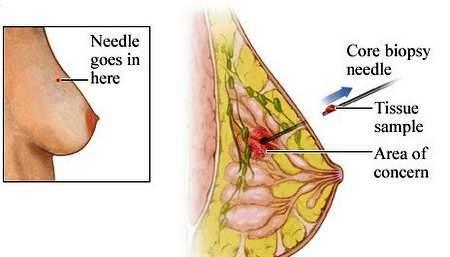 Before my second breast cancer surgery, my surgeon sent me for an ultrasound guided core-needle biopsy.
Before my second breast cancer surgery, my surgeon sent me for an ultrasound guided core-needle biopsy.
The core-needle biopsy identified the lump seen in my annual mammogram as a malignant tumor that was less than 1cm. The path report, following my surgery, reported an invasive breast cancer of 9mm. Given my experience, I read the following report, published in Radiology, with great interest.
A study was conducted in 2011 to examine the issue of under-staging of invasive breast cancer using core-needle biopsy (CNB). The purpose of the study was to evaluate the prevalence of under-staging, and to identify factors that predict invasive breast cancer.
The Main findings: In this analysis, about one in four Ductal carcinoma in situ (DCIS) diagnoses at CNB represented under-staged invasive breast cancer.
CNB is a diagnostic procedure in which cells are removed (with a large “core” needle) from a suspicious area to check for the presence of breast cancer. It is often guided by ultrasonography (US). Under- staging is an underestimate of how advanced a given cancer is. Under-staging is a known outcome of CNB. However, studies evaluating its frequency and contributing factors are lacking. This leaves physicians without a clear understanding of the prevalence and causes of under-staging. Cancer under -staging may lead to a wrong treatment plan.
The authors of the study analyzed 52 studies with a total of 7,350 DCIS diagnoses done via core-needle biopsy. Out of these 7,350 cases of DCIS there were 1,736 under estimates (23.6%), that turned out to be invasive breast cancer at excision.
The following factors were found to be associated with under-staging: US-guided biopsy; larger tumors found on imaging; presence of a palpable tumor; use of a large automated biopsy device; a mammogram showing a mass with features suggestive of a malignancy (e.g. high density).
The use of a vacuum-assisted biopsy device guided by stereotaxis (use of medical imaging to precisely locate in 3D a site to which the core needle is directed) was associated with a lower risk for under- staging.
Authors of the study suggest that if you are diagnosed with DCIS, talk to your doctor about your chances of under-staging.
Source: Radiology, a monthly journal devoted to clinical radiology and allied sciences.
Access to study in Radiology journal: Medivizor.com
 Before my second breast cancer surgery, my surgeon sent me for an ultrasound guided core-needle biopsy.
Before my second breast cancer surgery, my surgeon sent me for an ultrasound guided core-needle biopsy.
